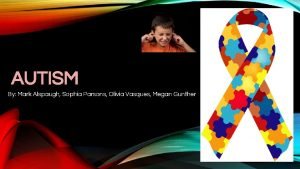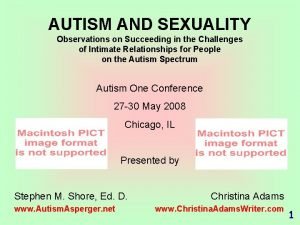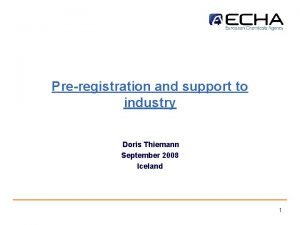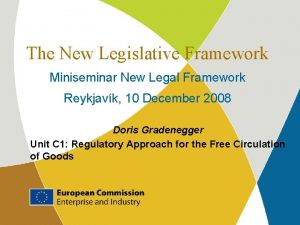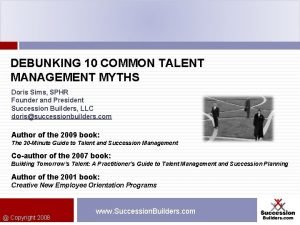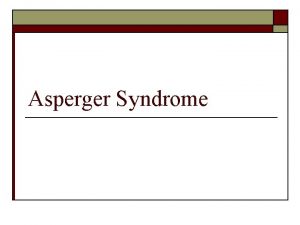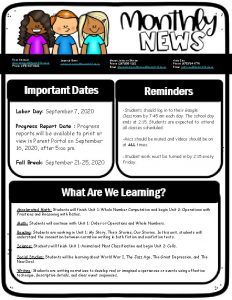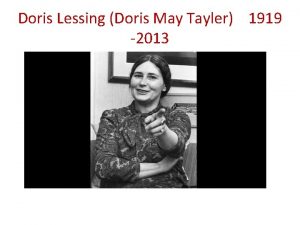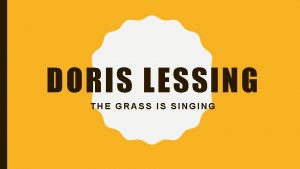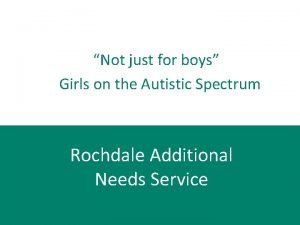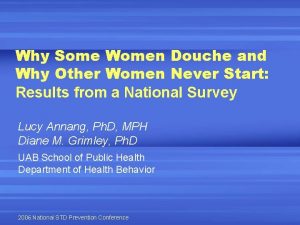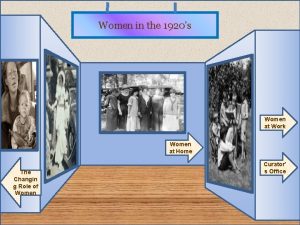The Other 25 Autistic Girls and Women Doris




































































- Slides: 68

The Other 25%: Autistic Girls and Women Doris M. Greenberg, MD Developmental and Behavioral Pediatrician Associate Clinical Professor of Pediatrics Mercer University School of Medicine Memorial Health University Medical Center Savannah, Georgia

Faculty Disclosure • Dr. Greenberg: Stockholder—Abbott, Abb. Vie, Glaxo. Smith. Kline, Johnson & Johnson, Novartis, Novo Nordisk (and spouse); Son Employee—Sanofi Pasteur

Disclosure • The faculty have been informed of their responsibility to disclose to the audience if they will be discussing off-label or investigational use(s) of drugs, products, and/or devices (any use not approved by the US Food and Drug Administration). • Applicable CME staff have no relationships to disclose relating to the subject matter of this activity. • This activity has been independently reviewed for balance.

Learning Objectives • Discuss the prevalence of autism spectrum disorders (ASD) in the United States, and specifically, in females • Examine the challenges females with ASD face during puberty, courtship, motherhood, and employment • Effectively communicate with and counsel female patients with ASD who may be very literal and require a different type of discussion than a “neurotypical” patient

DSM-5: Autism Spectrum Disorders A. Deficits in social communication and interaction (all 3): • Understanding socialemotional reciprocity • Using non-verbal communication • Difficulty maintaining relationships B. Repetitive and restrictive patterns of behavior, interests, or activities (2/4 needed): • Stereotypies • Insistence on sameness and inflexibility • Restricted and fixated interests of great intensity • Sensory issues American Psychiatric Association. Diagnostic and Statistical Manual of Mental Disorders, Fifth Edition. Arlington, VA: American Psychiatric Publishing, Inc. ; 2013.

DSM-5 (continued) • Excessive resistance to • Highly restricted and fixated change, verbal rituals and interests, obsessions with routines (excluding bedtime numbers or parts of objects, rituals unless very unusual), carrying items that are odd, rigid and literal thinking, preoccupations with certain compulsions, difficulty with things like tables, charts, transitions being overly perfectionistic, unusual fears • Difficulty with interpreting humor and inflexibility of thought, unable to appreciate irony American Psychiatric Association. Diagnostic and Statistical Manual of Mental Disorders, Fifth Edition. Arlington, VA: American Psychiatric Publishing, Inc. ; 2013.

DSM-5 (continued) • Sensory hypo- or hyper • Symptoms need to be reactivity, preoccupation present in the early with textures, tactile developmental years, but defensiveness—difficulty may not become impairing with having hair or nails cut, until social demand unusual visual activity— exceeds the limited watching movement, capabilities of the patient reflections, light patterns, etc • Sound, smell, taste, vestibular, visual perceptual atypicalities, eg, smelling or licking American Psychiatric Association. Diagnostic and Statistical Manual of Mental Disorders, Fifth Edition. Arlington, VA: American Psychiatric Publishing, Inc. ; 2013.

Severity, DSM-5 • Depends on degree of • Differentiate from those with communication difficulties just a social pragmatic and degree of restricted, communication disorder repetitive patterns of • Differentiate from behavior intellectual deficits or global • SYMPTOMS MAY BE developmental delay MASKED UNTIL LATER IN LIFE, BUT MUST BE PRESENT DURING EARLY DEVELOPMENT American Psychiatric Association. Diagnostic and Statistical Manual of Mental Disorders, Fifth Edition. Arlington, VA: American Psychiatric Publishing, Inc. ; 2013.

Interesting Numbers • In the general population, males are 4. 3: 1 females • 1. 95: 1 males to females in the population with intellectual disability • These numbers may not be accurate since females may camouflage their difficulties and may be undetected due to their ability to disguise their symptoms better than males Fombonne E. In: Volkmar FR, et al (Eds). Handbook of Autism and Pervasive Developmental Disorders. John Wiley & Sons, Inc. : Hoboken, NJ; 2005: 42 -69. Attwood T. The pattern of abilities and development of girls with Asperger’s syndrome. Available at: www. tonyattwood. com. au/index. php/books-by-tony/archived-papers/80 -the-pattern-of-abilities-anddevelopment-of-girls-with-aspergers-syndrome. Accessed April 15, 2015. Kopp S, et al. Eur Child Adolesc Psychiatry. 1992; 1(2): 89 -99.

Genetics Drive the Disorder The severe symptoms with communication and restricted, repetitive behaviors are almost all determined by genetics, unlike the 2011 study that declared that the environment is responsible to a significant degree Frazier TW, et al. J Autism Dev Disord. 2014; 44(8): 2013 -2225. Hallmayer J, et al. Arch Gen Psychiatry. 2011; 68(11): 1095 -1102.

Genetic Architecture in ASDs • Not simple: 100 s of genes are involved • Many genes encode proteins for synaptic formation, transcriptional regulation, and chromatin-remodeling pathways ASD = autism spectrum disorder. De Rubeis S, et al. Nature. 2014; 515(7526): 209 -215.

Female Genetic Differences • Greater number of copy number variants in females diagnosed with autism compared to the males (45% vs 30% for males) • Likely gene-disrupting mutations (called LGD mutations) significantly overlap the targets in males of lower intelligence quotients Iossifov I, et al. Nature. 2014; 515(7526): 216 -221.

Epigenetic Differences in Identical Twins • In identical twins, if 1 has autism, the other will have autism only 70% of the time • DNA methylation differences are present in the twin with autism Wong CC, et al. Mol Psychiatry. 2014; 19(4): 495 -503.

MRI Differences in Females with Autism vs Normal Brains • Decrease in gray matter • Increase in density bilaterally. In association and projection temporal lobes, orbitofibers of the frontal, parietal, frontal cortex—both posterior temporal lobe, and medially and laterally, right occipital lobes medial occipital lobe, and • Increase in commissural left frontal lobe fibers of the corpus • Smaller white matter callosum and anterior density in anterior temporal cerebellum lobe and pons MRI = magnetic resonance imaging. Craig MC, et al. Br J Psychiatry. 2007; 191: 224 -228.

Similar Brain Abnormalities in Both Genders • Males and females with autism showed a negative correlation between decreased gray matter in the right limbic system and qualitative abnormalities in reciprocal interaction Craig MC, et al. Br J Psychiatry. 2007; 191: 224 -228. • Similar brain regions were affected in both genders • Women had an excess of white matter in the cerebellum

Lower Functioning Autistic Women and Girls • More likely to have severe problems than males with low function and autism • Autism can be the behavioral presentation with genetic disorders like tuberous sclerosis, fragile X syndrome, and epilepsy • Both genetic and epigenetic influences are often present Volkmar FR, et al. J Autism Dev Disord. 1993; 23(4): 579 -591.

Focusing on the Higher Functioning Females with Autism • Much more difficult to diagnose • Females often exhibit less challenging behavior than males • They are not as likely to have as many special and intense interests • Diagnosis can be made with examinations, good histories, and instruments, eg, ADOS or ADI-R ADOS = Autism Diagnostic Observation Schedule; ADI-R = Autism Diagnostic Interview-Revised. Lord C, et al. J Autism Dev Disord. 1989; 19(2): 185 -212. Lord C, et al. J Autism Dev Disord. 1994; 24(5): 659 -685.

Toddlers with Autism • Amygdala size is larger in autistic toddlers vs normal age mates • Size positively correlated with severity of symptoms in the social and communication skills • Girls had a more robust size difference than boys Schumann C, et al. Biol Psychiatry. 2009; 66(10): 942 -949.

Not All Diagnosed Early • Some patients on the autism spectrum, especially women, may be totally missed in the younger ages • It is only when reviewing a life history and detecting symptoms in retrospect that some may be diagnosed • Some may be diagnosed when a child in the family receives the diagnosis of autism, and a family history is obtained—peripheral and first-degree relatives may receive a late diagnosis • Cynthia Kim reveals receiving a diagnosis at age 42 when her quirks and socially inept behaviors were finally attributed to ASD Kim C. Nerdy, Shy, and Socially Inappropriate: A User Guide to an Asperger Life. Philadelphia, PA: Jessica Kingsley Publishers; 2014.

Contrasting Females vs Males with ASD • In the high-functioning patients on the autism spectrum, females had more lifetime sensory symptoms acknowledged on questionnaires • Females had fewer sociocommunication difficulties than the males • Females had more selfreported autistic traits • Because of better superficially sociocommunication skills in adult females, they were often under-recognized and tended to receive diagnoses later in their lives than males • Females could be very controlling with typical peers Lai MC, et al. PLo. S One. 2011; 6(6): e 20835. Gould J, et al. Good Autism Practice. 2011; 12(1): 34 -41.

Girls and Boys Differ • Autistic boys may be more hyperactive than the girls; girls may be more controlling with typical peers • Girls may be more passive and collect information about people rather than things; may share interests with typical girls: horses, literature, animals, but intensity greater Gould J, et al. Good Autism Practice. 2011; 12(1): 34 -41.

Different Trajectories • Girls with autism were more • Girls worried, more than likely to model and imitate boys, about fitting in social actions around them, • Many of the boys of their disguising their symptoms age and diagnoses had no and resulting in missed friends; girls may have 1 diagnoses special friend, and the • Socially immature girls patient may appear shy and tended to be “mothered” by reticent compared to peers other girls in social play • Because they tended to be included in a group, teachers missed identifying them as loners Attwood T. The Complete Guide to Asperger’s Syndrome. Philadelphia, PA: Jessica Kingsley Publishers; 2007. Gould J, et al. Good Autism Practice. 2011; 12(1): 34 -41.

Theories Only • Perhaps different mechanisms involved with females and males • Females may be less vulnerable innately protective mechanisms • Females and males might have equal risk genetically, but other factors may allow females to better compensate for these risks Schwarz E, et al. Mol Psychiatry. 2011; 16(12): 1213 -1220. Skuse DH. Hum Mol Genet. 2005; 14 Spec No 1: R 27 -R 32.

More Theories • Females and males might have equal risk genetically, but other factors may allow females to better compensate for these risks • Is this an extreme of the male brain? Females with ASD may be more “malelike” Skuse DH. Trends Genet. 2007; 23(8): 387 -395. Baron-Cohen S, et al. Science. 2005; 310(5749): 819 -823.

Currently, Diagnosis of ASD is Behavioral • Boys had more unusual visual responses, stereotypy, and less appropriate play than females • Since females tended to have better superficial and communication skills, they may have been underdiagnosed Lord C, et al. J Autism Dev Disord. 1982; 12(4): 317 -330.

Differences in Toddlers • 157 boys and 42 girls between the ages of 1. 5 and 3. 9 years showed that in addition to better communication skills in females and more unusual play in males, females had more anxious and depressed symptoms • Females had more sleep problems • So much variation on the spectrum, it was hard to define definitive differences at this age Hartley SL, et al. J Autism Dev Disord. 2009; 39(12): 1715 -1722.

DISCO Interview • Helpful interview for patients in the adolescent and adult years • 320 items, completed by parent or caregiver • Good inter-rater reliability • Excellent sensitivity, moderate specificity • Recently, shorter form: DISCO, DSM-5 which appears to be as reliable and correlates now with the current DSM-5 • The most important indicators for ASD were those in the social-communication domain DISCO = Diagnostic Interview for Social and Communication Disorders. Billstedt E, et al. J Child Psychol Psychiatry. 2007; 48(11): 1102 -1110. Carrington SJ, et al. Research in Autism Spectrum Disorders. 2014; 8(6): 701 -715.

ADI-R • Takes 1. 5 to 2. 5 hours to administer • Useful in patients with mental age over 2 years • Can be purchased by MDs and psychologists, but for some, training sessions necessary before use; MDs and Ph. Ds do not require additional training Lord C, et al. J Autism Dev Disord. 1994; 24(5): 659 -685.

Diagnosing Adults with ASD • • • Direct interview and observation Add Hx of childhood behaviors Self-reports: very revealing in those who camouflage well Old testing Discussing female’s coping mechanisms in their social lives Lai MC, et al. PLo. S One. 2011; 6(6): e 20835.

Comparison of Adults with ASD and Normal Intelligence Females Males • As children, no difference from males • Less autistic behavior in adults than males • Cognitively about the same • Same amount of comorbid depression, anxiety, and OCD • As children, no difference from females • More autistic behavior than females • Cognitively about the same • Same amount of comorbid depression, anxiety, and OCD = obsessive-compulsive disorder. Lai MC, et al. PLo. S One. 2011; 6(6): e 20835.

Comorbidities Common in Both Genders • 70% of both genders between ages 10 and 14 years had other comorbidities • Greatest prevalence at this age – Social anxiety disorder: 29% – ADHD: 28%, and among these, 84% had a second comorbid diagnosis • It is therefore important to look for “other branches on the autism tree” ADHD = attention-deficit/hyperactivity disorder. Simonoff E, et al. J Am Acad Child Adolesc Psychiatry. 2008; 47(8): 921 -929.

How to “Camouflage Autism” • Females may be better at • These skills allow the consciously learning a females to “fly under the social script to act more radar, ” compared to the typical males on the spectrum • May learn by rote how to • Some may select the use reciprocal conversation, actions of popular peers, gestures, gaze, and socially their dress, mannerisms, appropriate affect—much etc, and effectively imitate like learning a part in a play these in exquisite detail • The stress of this roleplaying can be exhausting Attwood T. The Complete Guide to Asperger’s Syndrome. Philadelphia, PA: Jessica Kingsley Publishers; 2007.

Special Interests May Differ • Interests are less quirky and eccentric than those of males • Females may have fewer stereotyped activities and behaviors • Standard interviews may miss the special interests and their intensity Volkmar FR, et al. Am J Psychiatry. 1988; 145(11): 1404 -1408.

Increased Sensory Issues in Females • DSM-5 now includes sensory issues as one of the key symptoms: “unusual sensory behaviors” • May include over- and under-sensitivity to sensory stimuli • Self-reporting questionnaires may be better in picking this up than interviews—since the questionnaires may ask more items to assess sensory behaviors • It may be that “women show fewer but perceive more autistic features than males” American Psychiatric Association. Diagnostic and Statistical Manual of Mental Disorders, Fifth Edition. Arlington, VA: American Psychiatric Publishing, Inc. ; 2013. Lai MC, et al. PLo. S One. 2011; 6(6): e 20835.

Challenging Times for Females • • Early childhood Grade school Adolescence College, vocational training Dating, courtship, marriage Parenthood Working and careers

Early Years Are Less Problematic than Middle School Years and Later • Girls tend to be less • A New York Times article disruptive in the early reported that psychiatrists school years observed that high functioning men are more • As middle school approaches, Catherine Lord likely to go on and marry than the women studied of the University of Michigan observed a • Lainhart and Folstein subset, “literally dumbstruck showed that despite being by anxiety, ” when social 1: 4 females to males with demands escalate autism, half of the patients with mood disorders were females Bazelon E. What Autistic Girls Are Made of. The New York Times Magazine. August 5, 2007. Mc. Lennan JD, et al. J Autism Dev Disord. 1993; 23(2): 217 -227. Howlin P, et al. J Child Psychol Psychiatry. 2004; 45(2): 212 -229. Lainhart JE, et al. J Autism Dev Disord. 1994; 24(5): 587 -601.

Pubertal Challenges • Change, even small • Needing to understand the transitions, are difficult for subtleties of peer both genders on the autism interaction: becoming a spectrum greater problem—girls may • Puberty changes: body model themselves after a changes, sexual feelings, particular popular girl to fit new expectations regarding in behavior • Naiveté of these teens may • Many may rely on the lead to difficulties with computer/Internet to obtain peers, adults, and information: may lead to relationships with boys pornographic depictions that “become the tutor” Attwood T, et al. The Autism Spectrum, Sexuality and the Law: What every parent and professional needs to know. Philadelphia, PA: Jessica Kingsley Publishers; 2014: 132 -134.

Low Functioning Autism, Sexual Challenges in Women • Dealing with menses • Teach hygiene: wearing panty liners daily to get used to sensory aspect of wearing menstrual pads • Consider the use of implants or hormonal control to eliminate periods or minimize them Greenberg D. Personal experience. • Prevent pregnancy: lowfunctioning women may be abused and sexually assaulted despite best intentions of the family • Understanding premenstrual behavioral exacerbations and being prepared to treat for this

Vulnerability • Unable to know how to respond to teasing about romantic feelings or behaviors • Inability to read the dishonorable intentions of another • Unsure of courting rituals and conduct • May decide to be celibate and spend time with technology as a substitute friend • Often later in social and emotional development than peers: can be highly intelligent, but significantly delayed in other areas Attwood T, et al. The Autism Spectrum, Sexuality and the Law: What every parent and professional needs to know. Philadelphia, PA: Jessica Kingsley Publishers; 2014: 133 -135.

Executive Function Difficulties • People on the autism spectrum “live in the now, ” not looking at what the future consequences might be • This can result in problems with organization, planning, flexibility in solving problems, and with a one track mind and determination in acquiring information or obtaining a goal Attwood T, et al. The Autism Spectrum, Sexuality and the Law: What every parent and professional needs to know. Philadelphia, PA: Jessica Kingsley Publishers; 2014: 135.

Teaching Appropriate Sexual Behavior • Masturbatory behavior is normal in all levels of autism in both genders (and in neurotypical patients as well) • Teach the appropriate time, place, and safety • Teach that Internet sites may provide exaggerated or false information Attwood T, et al. The Autism Spectrum, Sexuality and the Law: What every parent and professional needs to know. Philadelphia, PA: Jessica Kingsley Publishers; 2014.

Obtaining Sexual Information • It is very important to provide accurate and timely information about sexual matters to autistic individuals to prevent them from turning to peers or the Internet for information • The autistic patient should understand appropriate touch and mutual agreement about intimacy. This should be taught by parents and caregivers Attwood T, et al. The Autism Spectrum, Sexuality and the Law: What every parent and professional needs to know. Philadelphia, PA: Jessica Kingsley Publishers; 2014: 139 -140.

Internet Misrepresentation • Pornographic sites give misinformation: sex games, physical pain, and exaggerated sexual behaviors • Relying on the Internet may make the person have an unrealistic idea of appropriate sexual practices Attwood T, et al. The Autism Spectrum, Sexuality and the Law: What every parent and professional needs to know. Philadelphia, PA: Jessica Kingsley Publishers; 2014.

The Need for Parental Monitoring • Often high functioning patients are experts in computers, and it is important to have safeguards in place to prevent logging into illegal sites • Families and friends need to safeguard their credit card information to prevent unwarranted spending • Both of these measures need to be explained to the adolescent to avoid dangers in illegal sites and dangers to finances Attwood T, et al. The Autism Spectrum, Sexuality and the Law: What every parent and professional needs to know. Philadelphia, PA: Jessica Kingsley Publishers; 2014: 141.

Intimacy Continuum • Often, adolescents and young adults may not understand the gradual continuum of intimacy • If they rely on Internet sources, the early and subtle steps toward intimacy are overlooked, and the steps that are needed early in the relationship are skipped • What is legal at what age must be discussed Attwood T, et al. The Autism Spectrum, Sexuality and the Law: What every parent and professional needs to know. Philadelphia, PA: Jessica Kingsley Publishers; 2014: 140.

Navigating Courtship Rituals • Learning signs of courtship: physical touching, complimenting, looking into eyes for prolonged period, moving closer, kissing on the cheek • Knowing how to deflect flirting by moving or turning away Steward R. The Independent Woman’s Handbook for Super Safe Living on the Autistic Spectrum. Philadelphia, PA: Jessica Kingsley Publishers; 2014: 85 -129.

When Sensory Problems Interfere with Relationships • Hypersensitive females may find that handshakes, hugging, and touching used in sex can hurt • A refusal to touch may be interpreted by others as rejection • Teaching friends to understand what is and is not tolerable for the patient may be useful Steward R. The Independent Woman’s Handbook for Super Safe Living on the Autistic Spectrum. Philadelphia, PA: Jessica Kingsley Publishers; 2014: 28.

Sensory Problems (continued) • Hyposensitivity may lead to painful sexual interaction and may require a gentler reciprocation to the partner in order to avoid injury or soreness • Some autistic people are very upset with change in routine, fearing the unknown Steward R. The Independent Woman’s Handbook for Super Safe Living on the Autistic Spectrum. Philadelphia, PA: Jessica Kingsley Publishers; 2014: 30.

Difficulties with Literal Interpretation of Language • Misinterpretation of language, eg, “Would you like to sleep with me? ” might be interpreted as wanting to share a bed for non-sexual reasons • Difficulty understanding voice intonation and body language—eye contact, facial expressions, hand gestures, and body movements Steward R. The Independent Woman’s Handbook for Super Safe Living on the Autistic Spectrum. Philadelphia, PA: Jessica Kingsley Publishers; 2014: 19 -20.

Like Males, Lack of Social Chit-Chat • May not be able to keep up • Rich imaginations, may with peers and their social escape into fiction with chatter subjects like fairies, witches, and may have • Girls have better imaginary friends imaginative play than boys on the spectrum • May have rich solitary imaginary world • Almost like they have a script and are socially in • May continue with doll play control into adulthood, remaining socially immature Nichols S. Girls Growing Up on the Autism Spectrum: What Parents and Professionals Should • Difficulty using imagination Know About the Pre-teen and Teenage Years. Philadelphia, PA: Jessica Kingsley Publishers; in social context 2009. Knickmeyer RC, et al. J Autism Dev Disord. 2008; 38(6): 1028 -1035. Gould J, et al. Good Autism Practice. 2011; 12(1): 34 -41.

Difficulty with Theory of Mind • Problems imagining what it would be like to be someone else • Difficulty imagining how another feels—lacking empathy • Difficulty imagining intent • Problems understanding a point-of-view and perspective • Sometimes physiologic cues can give a signal to an autistic person warning of danger when theory of mind does not seem to serve well Steward R. The Independent Woman’s Handbook for Super Safe Living on the Autistic Spectrum. Philadelphia, PA: Jessica Kingsley Publishers; 2014: 23.

Being Safe • Physician or therapist can • Teach patients to help autistic women understand flirting understand sexual safety behaviors • Help patients understand • Instruct girls and women sexual harassment, assault, about suggestive dressing, rape, sexual boundaries posturing, conversations to avoid being interpreted as having sexual intent Steward R. The Independent Woman’s Handbook for Super Safe Living on the Autistic Spectrum. Philadelphia, PA: Jessica Kingsley Publishers; 2014: 85 -129.

How to Help Autistic Women with Relationships • These suggestions are offered by an autistic woman who relates how to be helpful to her and others she has interviewed Steward R. The Independent Woman’s Handbook for Super Safe Living on the Autistic Spectrum. Philadelphia, PA: Jessica Kingsley Publishers; 2014.

Teaching about Relationships • Understanding the • Teach about the difference between casual between feeling lust and sexual relationships vs love romantic relationships • Realizing that there may be • Understanding intimacy and casual sexual relationships learning that having sex • Help patients learn to may not necessarily decide whether she wants indicate shared feelings to have sex or not Steward R. The Independent Woman’s Handbook for Super Safe Living on the Autistic Spectrum. Philadelphia, PA: Jessica Kingsley Publishers; 2014: 113 -120.

Obsessions • Women with autism may • When working with these have a subject that patients, call these completely occupies her circumscribed interests time rather than obsessive interests • She can memorize lots of facts and information about • A big problem may exist the subject when the patient is obsessed about another • She may see solutions and person who may not feel creative problem solving the same and reciprocate that is “outside the box” Steward R. The Independent Woman’s Handbook for Super Safe Living on the Autistic Spectrum. Philadelphia, PA: Jessica Kingsley Publishers; 2014: 329 -331.

Helping the Patient Avoid Manipulation • Making a script if it is • Help the patient imagine difficult to say no what things she could do with the friend that she • Asking advocate to say no would miss and imagining for her • Making a list of positive and how she could do these things without that person negative things about • Teach that loneliness is maintaining a friendship frightening, but being hurt is with the person worse • Teach that friends come and go, and people drift in and out of friendships Steward R. The Independent Woman’s Handbook for Super Safe Living on the Autistic Spectrum. Philadelphia, PA: Jessica Kingsley Publishers; 2014: 49 -50.

Counseling on How to Sustain Relationships • Teach the autistic woman to • Understanding that change, let the partner know how albeit uncomfortable, may she feels about him/her help to sustain relationships —new surroundings, • Help her to use words to schedules, and sexual express how she feels behaviors • Possibly writing down feelings and leaving them for the other person to read Steward R. The Independent Woman’s Handbook for Super Safe Living on the Autistic Spectrum. Philadelphia, PA: Jessica Kingsley Publishers; 2014: 162 -163.

Helping the Patient Discuss Being Autistic • Suggest that the patient • Telling others that the may say, “Sometimes I may patient is autistic—may become overwhelmed; at cause many reactions and that time, please leave me may scare off some people alone. ” • Autistic people may have • Point out that meltdowns the tendency to over-attach may cause relationships to and become too intense in deteriorate a relationship—and it is helpful to advise against this Steward R. The Independent Woman’s Handbook for Super Safe Living on the Autistic Spectrum. Philadelphia, PA: Jessica Kingsley Publishers; 2014.

Suggesting Appropriate Dress • Teach the patient that she • At times, clothing that is should be careful about suggestive may give the how much of her body she impression that the woman exposes is promiscuous • She should avoid wearing • Facial expressions and sexually suggestive slogans posturing may have hidden on her clothes implications. Chewing gum may reduce the possible • It is wise to avoid seeoverly expressive facial through clothing expressions Steward R. The Independent Woman’s Handbook for Super Safe Living on the Autistic Spectrum. Philadelphia, PA: Jessica Kingsley Publishers; 2014: 215 -218.

Evaluating: When is it a Date? • Teach that it is okay to ask, • Teach that certain topics “Is this a date? ” should be avoided early in dating: religion, health, past • Early in the interaction, it is relationships, how much acceptable to meet in a money she makes, sexual public place rather than a experiences, abuse private residence • If the other person refuses, • Learning to ask the other person about themselves or don’t continue topics and opinions they have Steward R. The Independent Woman’s Handbook for Super Safe Living on the Autistic Spectrum. Philadelphia, PA: Jessica Kingsley Publishers; 2014: 153 -156.

Counseling about Staying Out of Abusive Relationships • Autistic women, like • Red Flags neurotypical women, are – Partner refuses to give often loyal to abuser, and other time alone may not know how to – Partner isolates you from prevent abuse or leave friends and family • Realizing that it is abuse if – Partner hurts you physically or makes the other person forces you horrible derogatory to do things you don’t want remarks about you, and threatens to leave or humiliates you kick you out if you don’t – Partner is excessively • Recognizing red flags Steward R. The Independent Woman’s Handbook for Super Safe Living on the Autistic Spectrum. Philadelphia, PA: Jessica Kingsley Publishers; 2014: 134 -135. jealous – Partner takes control of the other person’s money

Teaching How to Apologize • It is not intuitive to admit responsibility when something goes wrong • It might be helpful to script how to apologize to help autistic woman to resolve arguments and handle criticisms Steward R. The Independent Woman’s Handbook for Super Safe Living on the Autistic Spectrum. Philadelphia, PA: Jessica Kingsley Publishers; 2014: 167 -170.

Help Create an Autism Alert Card • At www. zazzle. com, there is a template that can be used to make a personalized alert card that explains about the patient’s autism – It suggests what to do if an autistic person is in distress – It lists contact numbers in case of emergency • Also available from the National Autistic Society, walletsized, that can be produced during a difficult situation – Contains a leaflet about autism as well

Sample Autism Alert Card The National Autistic Society Autism. www. autism. org. uk/card. Accessed April 20, 2015.

Some Take-Home Messages • Autistic women may be • Women may have more difficult to detect due to sensory sensitivities than their ability to imitate more males with autism, but they socially appropriate may only reveal these on behaviors questionnaires rather than • Some women may not have face-to-face history taking a diagnosis until adulthood • Genetics may determine susceptibility to autism, but • The work of constantly epigenetics may determine “playing a role” may be expression exhausting and lead to anxiety and meltdowns

More Take-Home Messages • Autistic women with normal intelligence may marry, have families, and be very productive • Women with autism have many comorbidities: anxiety, depression, panic disorders • In their school years, women, like men, may have ADHD as a common comorbidity • You may know a few autistic women and girls—they are among us, and now it makes sense as you understand them in the context of their autism

Women: “Research Orphans” • Ami Klin who directs the Yale Autism Program calls females on the spectrum “research orphans” • He notes that women and girls on the spectrum are often excluded from studies of medications used for autism, and they are often culled from studies on autism • Is the world more forgiving of boys on the spectrum and their quirky behaviors, than for girls? • The numbers for autistic girls and women are small in research studies Bazelon E. What Autistic Girls Are Made of. The New York Times Magazine. August 5, 2007.

Work for the Future • Developing programs to mentor girls and women on the autism spectrum in schools, colleges, industry • Insistence on inclusion of females on the autism spectrum in pharmacologic research and other research projects • Searching for females on the spectrum when evaluating their children
 Autism
Autism Is tim burton autistic
Is tim burton autistic Autism and relationships
Autism and relationships Splitting defense mechanism example
Splitting defense mechanism example Girls to women
Girls to women Possessive adjectives and demonstrative pronouns
Possessive adjectives and demonstrative pronouns Ninfa de doris hija la más bella
Ninfa de doris hija la más bella Dekrüpteerimine mobiil id
Dekrüpteerimine mobiil id Doris turk
Doris turk Doris lussier texte sur la mort
Doris lussier texte sur la mort Doris fleischman
Doris fleischman Doris lessing to room nineteen summary
Doris lessing to room nineteen summary Doris duke foundation for islamic art
Doris duke foundation for islamic art David doris young
David doris young Doris matosic
Doris matosic Through the tunnel by doris lessing summary
Through the tunnel by doris lessing summary Doris thiemann
Doris thiemann Prof pastore
Prof pastore Doris weiserova
Doris weiserova Doris thiemann
Doris thiemann Doris foodle
Doris foodle Schulsystem
Schulsystem Purpúreas rosas sobre galatea
Purpúreas rosas sobre galatea Señales de duelo doris salcedo
Señales de duelo doris salcedo Doris pastore md
Doris pastore md Harry truman doris day
Harry truman doris day Doris gradenegger
Doris gradenegger Doris des arts
Doris des arts Doris kessler
Doris kessler Ebundles
Ebundles Family economics and financial education
Family economics and financial education Doris šestan
Doris šestan Doris agency management system
Doris agency management system Doris sims
Doris sims Thank you very much gentlemen
Thank you very much gentlemen Reportive definition
Reportive definition Self-initiated other-repair
Self-initiated other-repair Hình ảnh bộ gõ cơ thể búng tay
Hình ảnh bộ gõ cơ thể búng tay Slidetodoc
Slidetodoc Bổ thể
Bổ thể Tỉ lệ cơ thể trẻ em
Tỉ lệ cơ thể trẻ em Voi kéo gỗ như thế nào
Voi kéo gỗ như thế nào Tư thế worm breton là gì
Tư thế worm breton là gì Hát lên người ơi
Hát lên người ơi Môn thể thao bắt đầu bằng chữ f
Môn thể thao bắt đầu bằng chữ f Thế nào là hệ số cao nhất
Thế nào là hệ số cao nhất Các châu lục và đại dương trên thế giới
Các châu lục và đại dương trên thế giới Công thức tính thế năng
Công thức tính thế năng Trời xanh đây là của chúng ta thể thơ
Trời xanh đây là của chúng ta thể thơ Mật thư anh em như thể tay chân
Mật thư anh em như thể tay chân 101012 bằng
101012 bằng độ dài liên kết
độ dài liên kết Các châu lục và đại dương trên thế giới
Các châu lục và đại dương trên thế giới Thơ thất ngôn tứ tuyệt đường luật
Thơ thất ngôn tứ tuyệt đường luật Quá trình desamine hóa có thể tạo ra
Quá trình desamine hóa có thể tạo ra Một số thể thơ truyền thống
Một số thể thơ truyền thống Cái miệng xinh xinh thế chỉ nói điều hay thôi
Cái miệng xinh xinh thế chỉ nói điều hay thôi Vẽ hình chiếu vuông góc của vật thể sau
Vẽ hình chiếu vuông góc của vật thể sau Nguyên nhân của sự mỏi cơ sinh 8
Nguyên nhân của sự mỏi cơ sinh 8 đặc điểm cơ thể của người tối cổ
đặc điểm cơ thể của người tối cổ Thứ tự các dấu thăng giáng ở hóa biểu
Thứ tự các dấu thăng giáng ở hóa biểu Vẽ hình chiếu đứng bằng cạnh của vật thể
Vẽ hình chiếu đứng bằng cạnh của vật thể Tia chieu sa te
Tia chieu sa te Thẻ vin
Thẻ vin đại từ thay thế
đại từ thay thế điện thế nghỉ
điện thế nghỉ Tư thế ngồi viết
Tư thế ngồi viết Diễn thế sinh thái là
Diễn thế sinh thái là Các loại đột biến cấu trúc nhiễm sắc thể
Các loại đột biến cấu trúc nhiễm sắc thể

